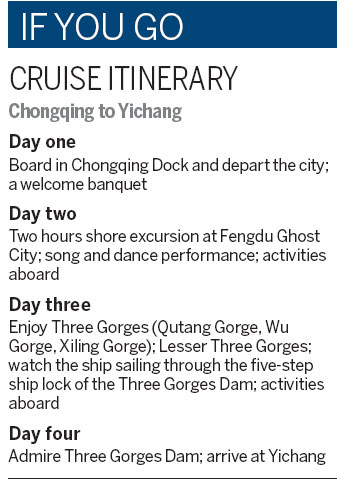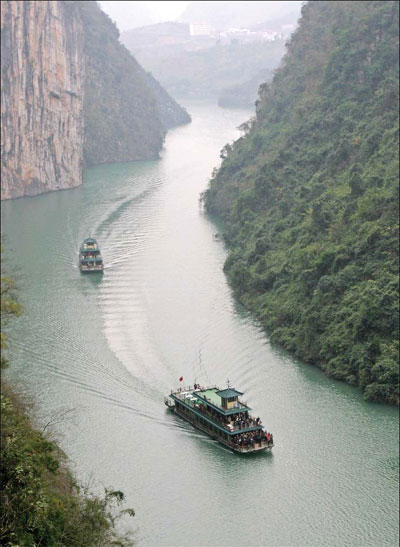The yin and the yangtze
Updated: 2011-12-02 07:36
By Chen Yingqun (China Daily)
|
|||||||||
|
The cost of a trip down the Yangtze River can vary from $400 to $800 and offers amazing sights. Mao Rendong / For China Daily |
Spectacular scenery makes cruising the Yangtze River a fantastic experience
The 6,397-kilometer Yangtze River is the longest river in Asia and flows from the Tibetan Plateau to the East China Sea at Shanghai. Traveling between Yichang and Chongqing takes four days and three nights and is the most popular route especially between April and May, and September and October.
"Laying back on the deck on a serene summer night, watching the starry sky and listening to the stream of the river murmur. Life cannot be better," says Huang Haizhen, a tourist from the Guangxi Zhuang autonomous region.
Most ships are about 100 meters long and 17 meters wide, with five floors and a capacity of about 150 people.
The luxurious four-star or five-star ships, which mainly target foreign tourists, charge from $600 to $850 which includes accommodation, meals and organized shore excursions.
All cabins have windows that open out onto the passing picturesque landscape. Some of the cabins even have balconies.
The ships are equipped with various recreation facilities, such as coffee house, library, card room, swimming pool, sauna, dancing hall and beauty salon.
Food is also a great pleasure. American-style buffet is usually served for breakfast, while various local cuisines are served for lunch and dinner.
The ship staff also holds all kinds of activities to entertain guests: a huge welcome banquet on the first night, which helps tourists to know one other; and a farewell dinner party for the last night, in which tourists can enjoy Chinese folk songs and dance, Chinese martial arts performance, and etc.
The organized entertainment is a treat for foreign visitors because it is packed with Chinese culture such as learning taichi, playing mahjong, appreciating painting and calligraphy.
By contrast, budget ships that target domestic tourists usually charge less than $400, and the cabins and food are not as good.
No matter what kind of ship you take, it won't make any difference in what sites you can see. There are three places of interest that almost no ships will miss: Fengdu Ghost City, Three Gorges, and the world-famous Three Gorges Dam.

Fengdu is a historical city famous for its ghost culture. Legend has it that in the Eastern Han Dynasty (AD 25-220), two scholars, Yin Changsheng and Wang Fangping, were passing through and were mistaken by later generations for the King of the Hell. Since then, the township has been known as the city of ghosts.
For thousands of years, legendary tales about ghosts and demons have been discussed around the city, and some believe that after death their spirit will be registered at the "Hell of Fengdu".
The current Fengdu ghost city has real tourist appeal with ancient trees towering to the sky and temples everywhere.
In the Devil's Shrine, China's biggest ghost culture landscape, there are ghostly images sporting all sorts of gestures and there are horrifying torture instruments on display.
The city uses sculptures to imitate courts, jails and torture scenes. It is also home to the biggest group of tombs from the Han Dynasty and is overshadowed by the beautiful Mingshan Mountain.
A major highlight along the river route is Three Gorges, one of China's top 10 scenic spots.
The Three Gorges consists of Qutang Gorge, Wu Gorge and Xiling Gorge and is about 191 km long.
The 8 km Qutang Gorge is the shortest of the three, but is considered the most dramatic by many travelers.
The narrowest place is only a few dozen meters wide, while some principal peaks on the banks are as high as 1,500 meters. The turbulent waters flowing into the deep gorge make a magnificent picture.
As the river cuts through the Wushan Mountains, its currents constantly change directions.
"As we cruised through the gorge, sometimes I found my view was blocked by mountains, but then a sharp turn of the ship brought us to a totally different scene. That was so amazing," says Luo Qun, a traveler from Yichang.
The 66 km Xiling Gorge is the longest of the Three Gorges. It used to be the most dangerous to travel through because it was full of shoals and rapid currents. Since the construction of the Three Gorges Dam, the waters have become calmer.
"In the twilight of the evening, half of the mountains are green while the other half are red," says Luo Aosi, a tourist from Shenzhen.
"The mountains, ships and people can see their reflections in the clear water, and all this constitutes an amazing picture."
The Three Gorges Dam is another famous iconic spot, which is the largest hydroelectric project in the world. The project is located at Sandouping, Hubei province.
The Three Gorges Dam is about 2,300 meters long and 185 meters high. There are many fantastic sights along the way, and this major engineering marvel is one of the best.
Sailing through the five-level ship lock is an interesting experience for passengers. When cruising downstream, the water level is lowered gradually to match the different water levels of each region.












